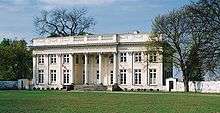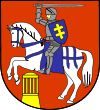Puławy
| Puławy | |||
|---|---|---|---|
|
Czartoryski Palace. | |||
| |||
 Puławy | |||
| Coordinates: 51°25′N 21°58′E / 51.417°N 21.967°E | |||
| Country |
| ||
| Voivodeship | Lublin | ||
| County | Puławy County | ||
| Gmina | Puławy (urban gmina) | ||
| Established | 16th century | ||
| Town rights | 1906 | ||
| Government | |||
| • Mayor | Janusz Grobel | ||
| Area | |||
| • Total | 50.49 km2 (19.49 sq mi) | ||
| Elevation | 115 m (377 ft) | ||
| Population (2006) | |||
| • Total | 49,839 | ||
| • Density | 990/km2 (2,600/sq mi) | ||
| Postal code | 24-100 to 24-112 | ||
| Area code(s) | +48 081 | ||
| Car plates | LPU | ||
| Website | http://www.um.pulawy.pl | ||
Puławy pronounced [puˈwavɨ] is a city in eastern Poland, in Lublin Province of northern Lesser Poland, located at the confluence of the Wisła and Kurówka rivers. According to the GUS census estimate, the city had a total population of 49,839 in 2006. Puławy is the capital of Puławy County, and was known as Nowa Aleksandria, or Nowo Aleksandria, from 1846 to 1918 during partitions of Poland. Its coat of arms is the Pahonia.
Puławy was first mentioned in documents in the 15th century. At that time, it was spelled as Pollavy, and its name probably comes from a Vistula river ford, which was located nearby. The town is a local center of science, industry and tourism, together with nearby Nałęczów and Kazimierz Dolny. Puławy is home to Poland’s first permanent museum, it also is a Vistula river port. The town has two bridges, four rail stations, and serves as a road junction. In the nearby Dęblin there is an airport. Puławy has several sports clubs, with the most famous ones being Wisła Pulawy (men’s football 2nd Eastern Division in 2012/13, swimming, track and field, weight lifting), and Azoty Puławy (men’s handball 1st Division).
Location and transport
Puławy lies in western part of the Lublin province, at the edge of the picturesque Lesser Polish Gorge of the Vistula, and near the easternmost point of the Vistula river. Historically the town belongs to Lesser Poland, and geographically, it lies at the border of Mazovian Lowland and Lublin Upland. The area of the town is 50.49 square kilometres (19.49 sq mi). Puławy is located National Road Nr. 12, which goes West - East, from łęknica at the German border, to Dorohusk at the Ukrainian border. Furthermore, the town has four rail stations (Puławy, Puławy Azoty, Puławy Chemia and Puławy Miasto). Long distance rail transport is served by the Puławy Miasto station, with connections to all Polish cities.
History
The history of Puławy dates back to the 15th century, when a settlement near a Vistula river ford was established. In the late 17th century it emerged as the location of a rural residence of the Lubomirski and the Sieniawski noble families and in 1676-1679, Prince Stanisław Herakliusz Lubomirski built a summer palace. In 1687, Lubomirski’s daughter Elżbieta (who was called the uncrowned Queen of Poland), married Adam Mikołaj Sieniawski, bringing Puławy her dowry. In 1706, during the Great Northern War, the settlement together with the castle were destroyed by Swedish soldiers as Elżbieta was a supporter of King Augustus II the Strong.
In 1731, Maria Zofia Sieniawska (the daughter of Elżbieta and Adam Sieniawski), married August Aleksander Czartoryski. As a result, Puławy remained in the hands of the Czartoryski family for the next 100 years. The settlement prospered, and in 1784 it became the property of Prince Adam Kazimierz Czartoryski and his wife Izabela Czartoryska, née Fleming. Under their stewardship, and after the loss of Poland's independence in 1795 (see Partitions of Poland) the palace became a museum of Polish national memorabilia and a major cultural and political centre. In 1784 Adam and Izabela moved permanently into the palace, and soon afterwards Puławy became known as Polish Athens. All major cultural figures of the late 18th century Poland visited the palace. Among them were Grzegorz Piramowicz, Franciszek Dionizy Kniaznin, Julian Ursyn Niemcewicz, Adam Naruszewicz, Jan Paweł Woronicz, Franciszek Karpiński, Franciszek Zabłocki, Jan Piotr Norblin, Marcello Bacciarelli. In 1794, during the Kościuszko Uprising, Puławy was plundered and burned by the Russians as punishment for the Czartoryski family's support of the rebels. The reconstruction of the palace was initiated in 1796 by Princess Izabela who employed the renowned architect Chrystian Piotr Aigner. In 1801, the Princess opened the first museum in Poland in the so-called Temple of Sibyl in Puławy.
The end of Puławy's Golden Age was marked by the November Uprising (1830–31), when after its suppression, the estate was taken over by the Russian government. The museum collections that were saved later became the nucleus of the present Czartoryski Museum in Kraków. In the 1830s, the Czartoryski family was forced to leave Russian-controlled Congress Poland (see Great Emigration), and Puławy was reduced into a small, provincial village. In 1842, to further erase traces of Polish culture, the Russians renamed Puławy to Nowa Aleksandria. In 1869, an Agricultural and Forestry Institute was founded here. One of its first students was the future Polish writer Bolesław Prus (who had also spent part of his early childhood in Puławy). Prus would set his 1884 micro-story, "Mold of the Earth," at the Temple of the Sibyl.
20th century
Puławy received its town charter in 1906. In 1915, it was seized by the Austro-Hungarian Army, which remained until November 1918. On 13 August 1920, Józef Piłsudski, Poland's Chief of State, left Warsaw, and established a military headquarters in Puławy. The Soviet Union's Red Army held most of eastern Poland and was besieging Warsaw, (see Polish-Soviet War). Piłsudski's radio-monitoring, cryptological and intelligence services detected a gap in the Soviet flanks in the Puławy region, and he ordered a concentration of Polish forces in the surrounding area around the Wieprz River. On 18 August 1920, the Polish Army launched a counter-attack from Puławy that encircled and defeated a 177,000-strong Soviet force. The attack drove the Red Army from Poland and established Poland's security for two decades, until the German invasion of 1939.

In the Second Polish Republic, Puławy began a slow process of modernization. In 1934, the town significantly grew in size, after several local villages merged with it. Furthermore, in the late 1930s Puławy took advantage of the Central Industrial Area. In September 1939, Puławy was seized by the Wehrmacht. During World War II, three German concentration camps operated around Puławy. The town's Jewish population of some 3,600 was first confined to a ghetto, then murdered at the Sobibór camp. The town remained under German occupation until July 25, 1944, when it was freed by the Home Army, as well as the Red Army. A year later, on April 24, 1945, a local unit of the anti-Communist organization Freedom and Independence under Marian Bernaciak captured the local office of Communist secret services temporarily.
Postwar history of Puławy has been dominated by the 1960 decision of the government of People's Republic of Poland to build a large chemical plant north of the town (Zakłady Azotowe Puławy). It was opened in 1966 and produced nitrate fertilizer. As a result, in the 1960s and 1970s Pulawy quickly grew in size, with new districts built for the influx of workers. Recently the plant has become the world's largest producer of melamine. In 1980 and 1981, Zakłady Azotowe Puławy was one of the largest centers of the Solidarity movement in the Lublin Region. After the declaration of Martial law in Poland (December 13, 1981), a strike action was initiated in the plant, which was put down by force by the ZOMO on Dec. 19, and 20 people were arrested.
Points of interest
The most valuable landmark in Puławy is the baroque-classicist palace and park complex, dating from 1676–79 (architect Tylman van Gameren), burned in 1706, remodeled 1722-36, and again by Chrystian Piotr Aigner ca. 1800. It includes classicist park pavilions dating from the early 19th century. One of these, the colonnaded round Temple of the Sibyl, is the setting Bolesław Prus' striking micro-story, "Mold of the Earth." In 2005 the inside of the main part of the complex was opened to visitors. Other buildings of the palace house the Soil and Fertilizer Institute. The palace is surrounded by a 30-hectare park, which was in 1798-1806 fashioned into an English landscape garden. Near the Temple of the Sibyl is the so-called Gothic House, built in 1800-09, to commemorate Prince Józef Poniatowski’s visit to Puławy. It now houses the Regional Museum. Among other interesting buildings located in the park are:
- Church of Ascension (1800–03), styled after the Pantheon, Rome,
- Palace of Marynka (1790–94), built for Maria Wirtemberska,
- Roman Gate, built in 1829 as a permanent ruin, styled after the Arch of Titus,
- Greek House (1778-1791), currently a public library,
- Yellow House, in which Tsar Alexander II of Russia stayed,
- Chinese Arbor,
- marble sarcophagus, brought from Rome in 1799 by Adam Jerzy Czartoryski,
- a 1790 sculpture of Clorinda and Tancredi (see Jerusalem Delivered).
In the town itself there are few interesting buildings, among which is a former town hall, former Orthodox church, and a historic inn.
Science
| Wikimedia Commons has media related to Puławy. |
Since early 20th century, Puławy has been a center of higher education. Among institutes operating here are:
- Institute of Soil Science and Plant Cultivation, opened in 1950, and based on an earlier school from 1917,
- The National Veterinary Research Institute, opened in 1945,
- Military Institute of Hygiene and Epidemiology,
- The Research Institute of Pomology and Floriculture, Division of Apiculture,
- Fertilizer Research Institute, moved in 1968 from Tarnów,
- Development Department at the Institute of Fundamental Technological of the Polish Academy of Sciences, since 1993 called Echo-Son SA.
Since 2008, local institutes, together with Town Council and the Kazimierz Pułaski University of Technology and Humanities in Radom have been working on a modern scientific campus, which will be located in the district of Azory. Among others, the complex will host four departments of the Radom University of Technology.
Gallery
-

Marynka's Palace, Puławy
-

Izabela Czartoryska, née Fleming
-

Temple of the Sibyl, Puławy
-

Prince Adam Jerzy Czartoryski Lyceum (secondary school)
Notable residents
- Adam Kazimierz Czartoryski
- Princess Izabela Czartoryska
- Adam Jerzy Czartoryski
- Maria Wirtemberska
- Adam of Württemberg (1792–1847), Duke of Württemberg, grandson of Princess Izabela Czartoryska.
- Bolesław Prus
- Beata Szymańska
Twin towns — sister cities
Puławy is twinned with:
|
See also
Bibliography
References
Coordinates: 51°25′N 21°58′E / 51.417°N 21.967°E
| |||||||||||||||||
| ||||||||||||
|




